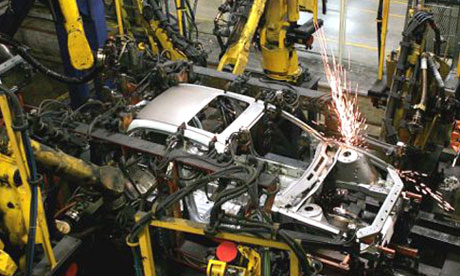Car Manufacture Robots

Function Of The Robots
To make the robots work , a computer programme is being installed on its computer controller . This helps in providing it with a precise instructions , therefore , the robots will do the orders which are asked to do , such as : Placing things , Rotating , and Welding. Robots can do jobs in extreme conditions. Robots can help the human in manufacturing the cars , by rotating it , leaving the human beings to work on some parts on it .
Identification Of Robots
Almost all robots in manufacturing cars , are single armed with a computer controller . Different robots are having various appendages , depending upon their job (s). For instance, a robot that places windshields will have a vacuum-powered suction grip to handle the smooth glass, while a welding robot will have an arc welder to fuse two pieces of metal together.
Benefits Of Robots
Robots have been a boon , for doing the manufacturing of cars with low percentage of worker injuries , including the unfortunate accidents that can lead to major harm.
Finally, robots save on the cost of labor: There are no sick days, strikes, work slowdowns or other problems that can crop up with humans. Robots can, in fact, work around the clock with a minimum of human supervision.
Now , watch this movie that shows how those robots can manufacture the wheels of the cars:)
http://www.google.com.om/url?sa=t&rct=j&q=car%20manufacture%20robots%20ppt&source=web&cd=1&cad=rja&ved=0CCsQFjAA&url=http%3A%2F%2Fwww.middlesexcc.edu%2Ffaculty%2Fsteven_zale%2FRobots%2520In%2520Manufacturing.ppt&ei=mGgPUevrPIrsrAfhiYCoDw&usg=AFQjCNE4PnabL0iNYIu7h8SbzwOn7eKwxg&bvm=bv.41867550,d.bmk
Central Heating Systems
Central heating systems provide heat
from a single point to multiple rooms, typically with a furnace or boiler and
vents, pipes, or radiators. Unlike local heating systems in which heat is
generated in a fireplace or stove and limited to a single room or small area,
central heating systems are designed to warm larger areas or entire structures.
The most common method of central heat generation requires the combustion of
fossil fuels such as oil, gas or coal. Wood-burning furnaces and electric
heating systems are also available. With forced air central heating systems,
the generated heat is distributed by forcing hot air through ductwork, vents
and plenums. Central heating systems that circulate water or feed steam through
pipes are also used in residential and commercial construction. Central heating
systems that burn fossil fuels for hot water circulation require supply lines,
a boiler or heat exchanger, heat pumps, and pipes and/or radiators. With gas
heat, the supply lines may run from a propane tank located outside the home,
building, or structure. Natural gas pipes and propane pipes should comply with
building codes and be installed by a professional plumber. Boilers and heat
exchangers are available in various configurations. Typically, heat exchangers
are categorized as parallel-flow or counter-flow. Specific types include shell
and tube, plate, and regenerative. Heat pumps are used to circulate the water
used in central heating systems. Radiators are wall or floor-mounted panels
through which the heated water passes before releasing heat into rooms. Like
other central heating systems, hydronic heating systems use the hot water from
a boiler or hot water heater as the medium for heat transfer. Radiators are
common, but radiant loops are also used. Aluminum-finned copper tubing and a
copper or cast iron baseboard runs in a continuous loop between rooms. By using
a mono-flow T fitting, a single pipe can feed the entire loop. Radiant floor
heating systems are also available. These central heating systems include pipes
that can be embedded in a concrete slab or attached to the underside of a
subfloor. To radiate heat downward from a ceiling, copper pipes may be attached
to the ceiling joists.










No comments:
Post a Comment